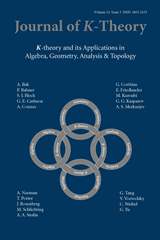No CrossRef data available.
Article contents
Equivariant K-theory of compact Lie groups with involution
Published online by Cambridge University Press: 24 February 2014
Abstract
For a compact simply connected simple Lie group G with an involution α, we compute the G ⋊ ℤ/2-equivariant K-theory of G where G acts by conjugation and ℤ/2 acts either by α or by g ↦ α(g)−1. We also give a representation-theoretic interpretation of those groups, as well as of KG(G).
Keywords
- Type
- Research Article
- Information
- Copyright
- Copyright © ISOPP 2014
References
1.Adem, A., Gomez, J.M.: Equivariant K-theory of compact Lie group actions with maximal rank isotropy, to appear in J. Topology.Google Scholar
2.Brylinski, J.-L., Zhang, B.: Equivariant K-theory of compact connected Lie groups, K-Theory 20(1) (2000), 23–36.Google Scholar
4.Dold, A., Thom, R.: Quasifaserungen und unendliche symmetrische produkte, Ann. of Math. 67(2) (1958), 239–281.Google Scholar
5.Elmendorf, A., Mandell, M.: Permutative categories as a model of connective stable homotopy, in: Richter, Birgit (ed.), Structured Ring spectra, Cambridge University Press, 2004.Google Scholar
6.Freed, D., Hopkins, M., Teleman, C.: Loop Groups and twisted K-theory I, J. Topology 4 (2011), 737–798.CrossRefGoogle Scholar
7.Frenkel, E.: Lectures on the Langlands Program and Conformal Field Theory, Les Houches 2005.Google Scholar
8.Greenlees, J.P.C., May, J.P.: Completions in algebra and topology, Handbook of Algebraic Topology (ed. James, I. M.), North-Holland, 1995, 255–276.CrossRefGoogle Scholar
9.Greenlees, J.P.C., May, J.P.: Generalized Tate cohomology, Memoirs of the A.M.S. 543 (1995), pp. 178.Google Scholar
10.Helgason, S.: Differential Geometry, Lie Groups and Symmetric Spaces, Grad. Studies in Math. 34, reprinted with corrections, Amer. Math. Soc. 2001.Google Scholar
11.Hill, M.A., Hopkins, M.J., Ravenel, D.C.: On the non-existence of elements of Kervaire invariant one, Archive preprint: http://arxiv.org/abs/0908.3724.Google Scholar
12.Kriz, I., Lai, L.: On the definition and K-theory realization of a modular functor, preprint, 2013.Google Scholar
13.Lewis, G. Jr., May, J.P., Steinberger, M.: Equivariant stable homotopy theory, Springer, (1986), pp. 538.Google Scholar
14.May, J.P.: A Concise Course in Algebraic Topology, Chicago Lectures in Math. 1999, University of Chicago Press.Google Scholar
15.May, J.P.: Weak equivalences and quasifibrations, Groups of self-equivalences and related topics (Montreal, PQ, 1988), Lecture Notes in Math. 1425, Springer, Berlin (1990) 91–101.Google Scholar
16.Pressley, A., Segal, G.: Loop groups, Oxford Mathematical Monographs, Oxford University Press, New York, 1986.Google Scholar
17.Segal, G.: The representation-ring of a compact Lie group, Publ. Math. I.H.E.S. 34 (1968), 113–128.Google Scholar




